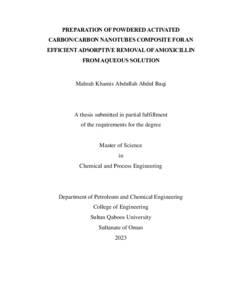Document
Performance of mineral oil based multi-walled carbon nanotubes nanolubricant in vapor compression refrigeration system: an experimental study.
Identifier
DOI:10.53540/tjer.vol.21iss2pp87-96
Source
Journal of Engineering Research, v. 21, no. 2, p. 87-96.
Contributors
Tariq, Mohammad., Author
Husain, Afzal., Author
Other titles
أداء زيت معدني يعتمد على أنابيب الكربون النانوية متعددة الجدران كسائل تزييت نانوي في نظام تبريد انضغاطي بخاري: دراسة تجريبية.
Country
Oman
City
Muscat
Publisher
College of Engineering, Sultan Qaboos University.
Gregorian
2025-01-08
Language
English
Subject
English abstract
Extensive research has been carried out to design an efficient refrigeration system that consumes less energy. This study investigated the use of a hydrocarbon blend refrigerant (LPG) mixed with mineral oil-based multi-walled carbon nanotube (MWCNT) nanolubricant at different concentrations (0.2, 0.4, and 0.6 g/L) as a replacement for the conventional working fluid R134a and polyolester (POE) oil. The results showed that using 0.4 g/L of nanolubricant with LPG reduced the pressure ratio and compressor energy consumption by 54.3% and 25%, respectively, and improved the coefficient of performance (COP) by 25% compared to R134a/POE. The study concluded that the optimal nanolubricant concentration among all working fluids was 0.4 g/L.
ISSN
Online: 1726-6742
Print: 1726-6009
Arabic abstract
تم إجراء بحوث مكثفة بهدف تصميم نظام تبريد فعال يستهلك طاقة أقل. تناولت هذه الدراسة استخدام مزيج تبريد هيدروكربوني (LPG) مع زيت معدني مدعم بأنابيب الكربون النانوية متعددة الجدران (MWCNT) بتركيزات مختلفة (0.2، 0.4، و0.6 جم/لتر) كبديل للسائل العامل التقليدي R134a وزيت بوليوليستر (POE). أظهرت النتائج أن استخدام 0.4 جم/لتر من سائل التزييت النانوي مع LPG يقلل نسبة الضغط واستهلاك طاقة الضاغط بنسبة 54.3٪ و25٪ على التوالي، كما يحسن معامل الأداء (COP) بنسبة 25٪ مقارنة بـ R134a/POE. وخلصت الدراسة إلى أن التركيز المثالي لسائل التزييت النانوي بين جميع السوائل العاملة هو 0.4 جم/لتر.
Category
Journal articles

